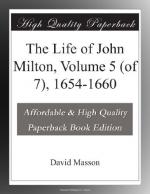Vol. V. p. 227, in connexion with Vol. IV, pp. 487-494:—A paper found very recently by Mrs. Everett Green in the Record Office, and kindly communicated by her to me, in continuation of those for which I have already acknowledged my obligations to her, enables me to throw some further light on Milton’s friend and correspondent Andrew Sandelands, and on that scheme of his for utilising the fir-woods of Scotland in which he sought Milton’s assistance. The paper, which is in the handwriting of Sandelands, is dated “30 June, 1653,” i.e. two months and ten days after Cromwell had dissolved the Rump and begun his Interim Dictatorship; it is addressed “For the Honor’ble. Sir Gilbert Pickering”—Pickering being then, it would seem, President of Cromwell’s Interim Council of Thirteen (see Vol. IV. pp, 498-499); and it is headed “A Brief Narration of my Transactions concerning some Woods in Scotland.” From this statement of Sandelands it appears that he had first broached his scheme of obtaining masts and tar for the English navy from the woods of Scotland to Cromwell himself in August 1652, and that it was in consequence of Cromwell’s recommendation of the scheme to the Council of State then in power that the business had been referred to the Commander-in-chief in Scotland and Sandelands had gone to Scotland ("at my own charge,” he says) and had the conferences with Major-General Dean and Colonel Lilburne described at pp. 490-491 of Vol. IV. The result had been that detailed written explanation of his scheme to Lilburne the substance of which has been quoted in the same pages—“the copy whereof,” adds Sandelands, “now remains in Mr. Thurloe’s hands.” He means, of course, the copy he had enclosed to Milton in his letter of Jan. 15, 1652-3, and which Milton had duly delivered to the Council of State. More had come of the matter than we knew at that date; for Sandelands proceeds thus in his statement:—“The Council of State, having received this information (recommended by the Commander-in-chief), gave order that Colonel Lilburne should prosecute the design effectually. Upon receipt of which order, Colonel Lilburne was pleased to employ me to try whether the Earl of Tullibardine (who had an interest of the third part of the woods of Abernethy and Glencalvie) would sell his share; which I did, and brought with me an agreement under his hand that for L221 he would yield up all his interest in the former woods and all other be-north Tay, upon condition that the money should be paid before the 25th of March last [1653]; which Colonel Lilburne certified to the Council of State. But, their greater affairs [the discussions with Cromwell just before his coup d’etat] obstructing this design, neither money nor orders were sent. Therefore I did entreat Colonel Lilburne to do me that justice to certify my diligence; which he did; and [having come to London meanwhile] I delivered it to his Excellency [Cromwell] the 12th of June [a month and three weeks after the




